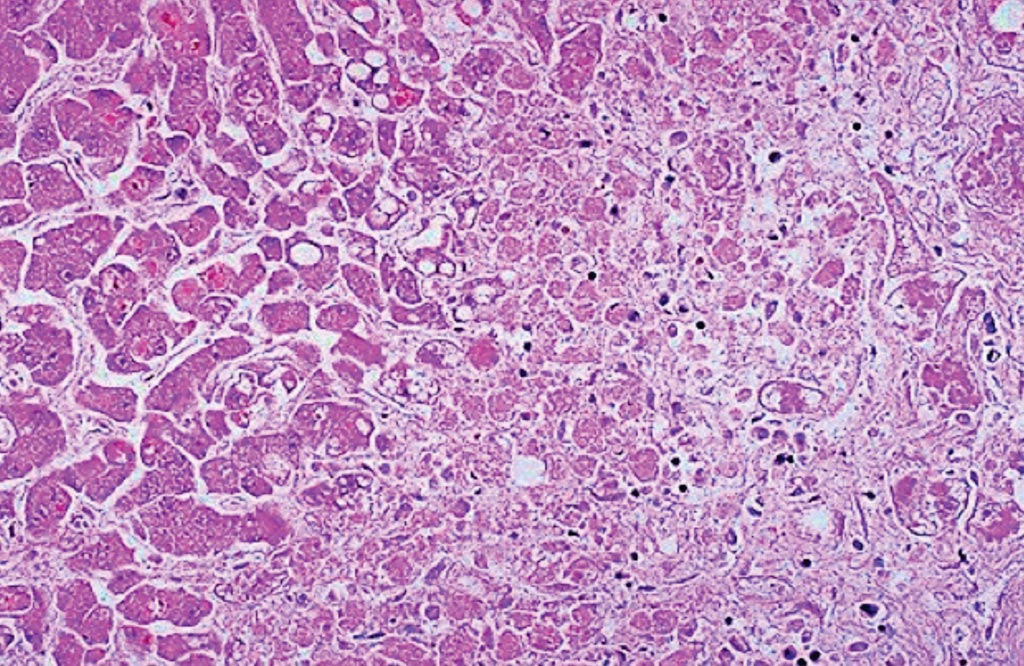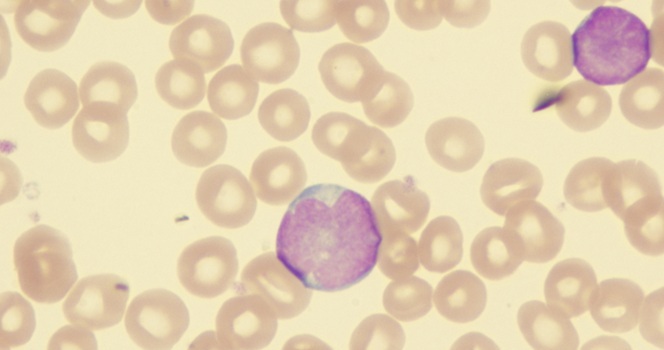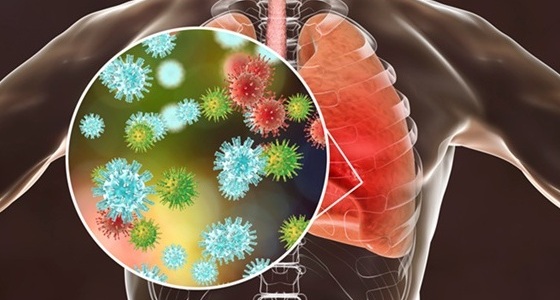Test Detects Overdose Patients at Risk of Liver Damage
|
By LabMedica International staff writers Posted on 28 Nov 2017 |

Image: A histopathology of extensive hepatocyte necrosis seen here in a case of paracetamol overdose. The hepatocytes at the right are dead, and those at the left are dying. This pattern can be seen with a variety of hepatotoxins (Photo courtesy of the University of Utah Medical School).
Paracetamol is a safe analgesic drug when taken at therapeutic doses; however, in overdose, paracetamol is hepatotoxic and is the most common cause of acute liver failure in the USA and Europe.
Current markers, serum alanine aminotransferase (ALT) activity and paracetamol concentration, lack sensitivity and specificity when measured soon after overdose such as at initial presentation to hospital. These limitations are further compounded in staggered overdose, for which there is an increased acute liver injury risk, but for which treatment nomograms are not recommended.
A team of medical scientists by the University of Liverpool (Liverpool, UK) and the University of Edinburgh (Edinburgh, UK) recruited two cohorts to assess the potential for biomarkers to stratify patients who overdose with paracetamol. The team completed two independent prospective studies: a derivation study (MAPP) in eight UK hospitals and a validation study (BIOPAR) in ten UK hospitals. Patients in both cohorts were adults (≥18 years in England, ≥16 years in Scotland), were diagnosed with paracetamol overdose.
Blood sample taken at first presentation to hospital was stored at −80 °C as plasma or serum. All blood results from the first hospital admission were recorded (paracetamol, alkaline phosphatase, γ-glutamyl transferase, bilirubin, creatinine, and alanine aminotransferase (ALT) concentration, prothrombin time, and international normalized ratio [INR]). The primary endpoint was acute liver injury indicating need for continued acetylcysteine treatment beyond the standard course (ALT activity >100 U/L.
The reference standard of injury was ALT concentration. MicroRNA-122 (miR-122), high mobility group box-1 (HMGB1), caspase-cleaved keratin-18 (K18), full-length K18, and glutamate dehydrogenase (GLDH) were measured in the admission blood sample, with miR-122 measured by polymerase chain reaction (PCR) and other markers measured by enzyme-linked immunosorbent assay (ELISA). Each biomarker was measured in each sample in duplicate. miR-122 concentration was expressed with reference to the circulating microRNA let-7d as the internal microRNA normalizer.
The team reported that between June 2, 2010, and May 29, 2014, 1,187 patients who required acetylcysteine treatment for paracetamol overdose were recruited (985 in the MAPP cohort; 202 in the BIOPAR cohort). In the derivation and validation cohorts, acute liver injury was predicted at hospital presentation by miR-122, HMGB1, and full-length K18, and results were similar in the validation cohort. A combined model of miR-122, HMGB1, and K18 predicted acute liver injury better than ALT alone.
James W Dear, FRCP, the lead author of the study, said, “Paracetamol overdose is very common and presents a large workload for already over-stretched Emergency Departments. These new blood tests can identify who will develop liver injury as soon as they first arrive at hospital. This could transform the care of this large, neglected, patient group.” The study was published on November 13, 2017, in the journal Lancet Gastroenterology & Hepatology.
Related Links:
University of Liverpool
University of Edinburgh
Current markers, serum alanine aminotransferase (ALT) activity and paracetamol concentration, lack sensitivity and specificity when measured soon after overdose such as at initial presentation to hospital. These limitations are further compounded in staggered overdose, for which there is an increased acute liver injury risk, but for which treatment nomograms are not recommended.
A team of medical scientists by the University of Liverpool (Liverpool, UK) and the University of Edinburgh (Edinburgh, UK) recruited two cohorts to assess the potential for biomarkers to stratify patients who overdose with paracetamol. The team completed two independent prospective studies: a derivation study (MAPP) in eight UK hospitals and a validation study (BIOPAR) in ten UK hospitals. Patients in both cohorts were adults (≥18 years in England, ≥16 years in Scotland), were diagnosed with paracetamol overdose.
Blood sample taken at first presentation to hospital was stored at −80 °C as plasma or serum. All blood results from the first hospital admission were recorded (paracetamol, alkaline phosphatase, γ-glutamyl transferase, bilirubin, creatinine, and alanine aminotransferase (ALT) concentration, prothrombin time, and international normalized ratio [INR]). The primary endpoint was acute liver injury indicating need for continued acetylcysteine treatment beyond the standard course (ALT activity >100 U/L.
The reference standard of injury was ALT concentration. MicroRNA-122 (miR-122), high mobility group box-1 (HMGB1), caspase-cleaved keratin-18 (K18), full-length K18, and glutamate dehydrogenase (GLDH) were measured in the admission blood sample, with miR-122 measured by polymerase chain reaction (PCR) and other markers measured by enzyme-linked immunosorbent assay (ELISA). Each biomarker was measured in each sample in duplicate. miR-122 concentration was expressed with reference to the circulating microRNA let-7d as the internal microRNA normalizer.
The team reported that between June 2, 2010, and May 29, 2014, 1,187 patients who required acetylcysteine treatment for paracetamol overdose were recruited (985 in the MAPP cohort; 202 in the BIOPAR cohort). In the derivation and validation cohorts, acute liver injury was predicted at hospital presentation by miR-122, HMGB1, and full-length K18, and results were similar in the validation cohort. A combined model of miR-122, HMGB1, and K18 predicted acute liver injury better than ALT alone.
James W Dear, FRCP, the lead author of the study, said, “Paracetamol overdose is very common and presents a large workload for already over-stretched Emergency Departments. These new blood tests can identify who will develop liver injury as soon as they first arrive at hospital. This could transform the care of this large, neglected, patient group.” The study was published on November 13, 2017, in the journal Lancet Gastroenterology & Hepatology.
Related Links:
University of Liverpool
University of Edinburgh
Latest Clinical Chem. News
- Chemical Imaging Probe Could Track and Treat Prostate Cancer
- Mismatch Between Two Common Kidney Function Tests Indicates Serious Health Problems
- VOCs Show Promise for Early Multi-Cancer Detection
- Portable Raman Spectroscopy Offers Cost-Effective Kidney Disease Diagnosis at POC
- Gold Nanoparticles to Improve Accuracy of Ovarian Cancer Diagnosis
- Simultaneous Cell Isolation Technology Improves Cancer Diagnostic Accuracy
- Simple Non-Invasive Hair-Based Test Could Speed ALS Diagnosis
- Paper Strip Saliva Test Detects Elevated Uric Acid Levels Without Blood Draws
- Prostate Cancer Markers Based on Chemical Make-Up of Calcifications to Speed Up Detection
- Breath Test Could Help Detect Blood Cancers
- ML-Powered Gas Sensors to Detect Pathogens and AMR at POC
- Saliva-Based Cancer Detection Technology Eliminates Need for Complex Sample Preparation
- Skin Swabs Could Detect Parkinson’s Years Before Symptoms Appear
- New Clinical Chemistry Analyzer Designed to Meet Growing Demands of Modern Labs

- New Reference Measurement Procedure Standardizes Nucleic Acid Amplification Test Results
- Pen-Like Tool Quickly and Non-Invasively Detects Opioids from Skin
Channels
Molecular Diagnostics
view channel
Simple Urine Test to Revolutionize Bladder Cancer Diagnosis and Treatment
Bladder cancer is one of the most common and deadly urological cancers and is marked by a high rate of recurrence. Diagnosis and follow-up still rely heavily on invasive cystoscopy or urine cytology, which... Read more
Blood Test to Enable Earlier and Simpler Detection of Liver Fibrosis
Persistent liver damage caused by alcohol misuse or viral infections can trigger liver fibrosis, a condition in which healthy tissue is gradually replaced by collagen fibers. Even after successful treatment... Read moreHematology
view channel
Platelet Activity Blood Test in Middle Age Could Identify Early Alzheimer’s Risk
Early detection of Alzheimer’s disease remains one of the biggest unmet needs in neurology, particularly because the biological changes underlying the disorder begin decades before memory symptoms appear.... Read more
Microvesicles Measurement Could Detect Vascular Injury in Sickle Cell Disease Patients
Assessing disease severity in sickle cell disease (SCD) remains challenging, especially when trying to predict hemolysis, vascular injury, and risk of complications such as vaso-occlusive crises.... Read more
ADLM’s New Coagulation Testing Guidance to Improve Care for Patients on Blood Thinners
Direct oral anticoagulants (DOACs) are one of the most common types of blood thinners. Patients take them to prevent a host of complications that could arise from blood clotting, including stroke, deep... Read moreImmunology
view channel
New Test Distinguishes Vaccine-Induced False Positives from Active HIV Infection
Since HIV was identified in 1983, more than 91 million people have contracted the virus, and over 44 million have died from related causes. Today, nearly 40 million individuals worldwide live with HIV-1,... Read more
Gene Signature Test Predicts Response to Key Breast Cancer Treatment
DK4/6 inhibitors paired with hormone therapy have become a cornerstone treatment for advanced HR+/HER2– breast cancer, slowing tumor growth by blocking key proteins that drive cell division.... Read more
Chip Captures Cancer Cells from Blood to Help Select Right Breast Cancer Treatment
Ductal carcinoma in situ (DCIS) accounts for about a quarter of all breast cancer cases and generally carries a good prognosis. This non-invasive form of the disease may or may not become life-threatening.... Read moreMicrobiology
view channel
Rapid Diagnostic Test Matches Gold Standard for Sepsis Detection
Sepsis kills 11 million people worldwide every year and generates massive healthcare costs. In the USA and Europe alone, sepsis accounts for USD 100 billion in annual hospitalization expenses.... Read moreRapid POC Tuberculosis Test Provides Results Within 15 Minutes
Tuberculosis remains one of the world’s deadliest infectious diseases, and reducing new cases depends on identifying individuals with latent infection before it progresses. Current diagnostic tools often... Read more
Rapid Assay Identifies Bloodstream Infection Pathogens Directly from Patient Samples
Bloodstream infections in sepsis progress quickly and demand rapid, precise diagnosis. Current blood-culture methods often take one to five days to identify the pathogen, leaving clinicians to treat blindly... Read morePathology
view channel
Tunable Cell-Sorting Device Holds Potential for Multiple Biomedical Applications
Isolating rare cancer cells from blood is essential for diagnosing metastasis and guiding treatment decisions, but remains technically challenging. Many existing techniques struggle to balance accuracy,... Read moreAI Tool Outperforms Doctors in Spotting Blood Cell Abnormalities
Diagnosing blood disorders depends on recognizing subtle abnormalities in cell size, shape, and structure, yet this process is slow, subjective, and requires years of expert training. Even specialists... Read moreTechnology
view channel
Artificial Intelligence Model Could Accelerate Rare Disease Diagnosis
Identifying which genetic variants actually cause disease remains one of the biggest challenges in genomic medicine. Each person carries tens of thousands of DNA changes, yet only a few meaningfully alter... Read more
AI Saliva Sensor Enables Early Detection of Head and Neck Cancer
Early detection of head and neck cancer remains difficult because the disease produces few or no symptoms in its earliest stages, and lesions often lie deep within the head or neck, where biopsy or endoscopy... Read moreIndustry
view channel
Abbott Acquires Cancer-Screening Company Exact Sciences
Abbott (Abbott Park, IL, USA) has entered into a definitive agreement to acquire Exact Sciences (Madison, WI, USA), enabling it to enter and lead in fast-growing cancer diagnostics segments.... Read more






















